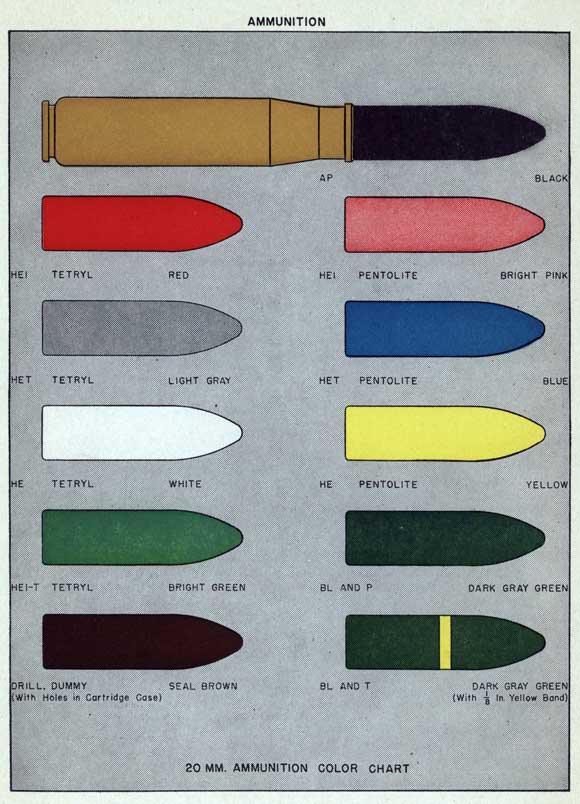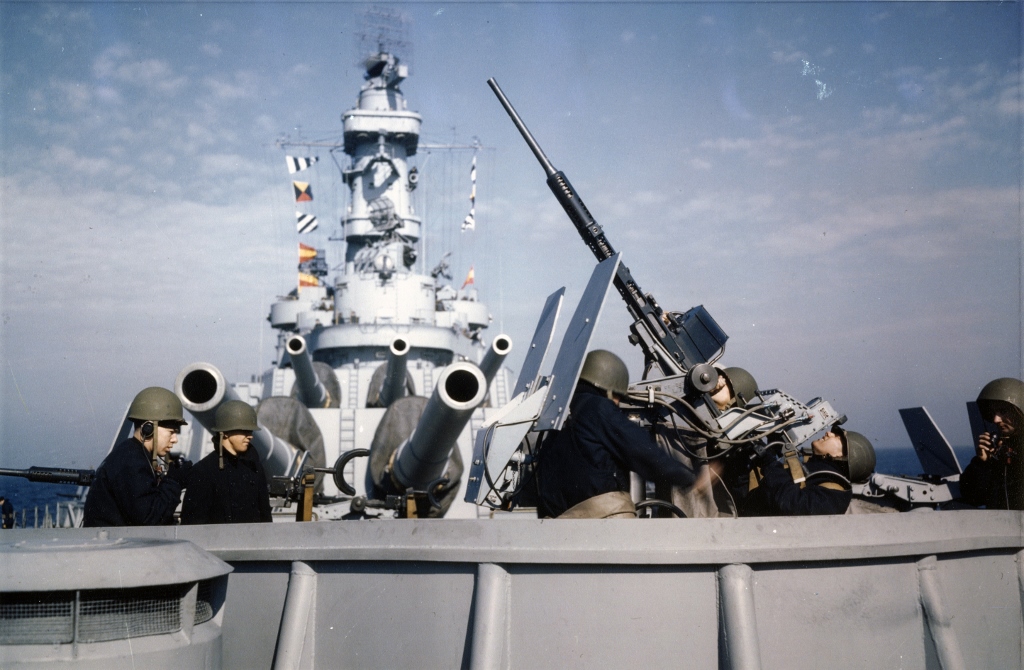
Widely used by many nations, this 20 mm automatic weapon originally designed by the Swiss firm of Oerlikon was probably produced in higher numbers than any other AA weapon of World War II.
In 1937 the British Admiralty initiated tests to find a weapon suitable for arming merchant ships and minor warships against close range air attacks. They rejected the Oerlikon Model 1934, but in 1938 the Admiralty informed Oerlikon that if they could raise the muzzle velocity and demonstrate that the weapon could be used and maintained by non-specialist personnel, such as fishermen and merchant seamen, then it would be acceptable. Oerlikon made the necessary changes and the first prototypes of the new design were delivered late in 1939. These were immediately accepted into service as the 20 mm Mark I and Britain placed large orders with Oerlikon and obtained a manufacturing license. However, only a few additional guns were delivered prior to the German occupation of France, which cut off the supply route. This is basically why so few British ships had Oerlikon guns during the early part of the war, with the official USN BuOrd history stating that the Royal Navy had only 100 Oerlikons at sea in November 1940.
Shortly before France fell, the British took advantage of their manufacturing license with Oerlikon to obtain a set of production drawings. These were brought back from Switzerland by Stewart Mitchell, who had previously been Inspector of Naval Ordnance Contracts at the Oerlikon factory in Zurich. Mitchell, together with the famous ordnance expert Charles Goodeve and with Cmdr. S.W. Roskill (then working in the Admiralty Staff Division and later the famous Capt. Roskill, author of "The War at Sea") set up a factory at Ruislip to produce Oerlikon guns. "Considerable difficulties" with equipment and labor had to be overcome before deliveries of the British version of this gun, designated as the 20 mm Mark II, began in the fall of 1941. In November 1941, the battleship HMS Duke of York was commissioned with six of these weapons, which I believe to have been the first warship to carry British-produced Oerlikon guns "as completed."
It is not specifically known how many guns were built by Britain and the Dominion nations, but the Mounting Appropriation Lists of September 1945 show about 55,000 guns in service in the British and Commonwealth navies. This total probably includes weapons built in the USA that were provided as a part of Lend-Lease or installed on those ships refitted in US shipyards. Some British Auxiliary ships still carried these weapons as late as 2006.
In 1935 the USN purchased two Oerlikon 20 mm Model 1934 guns for evaluation purposes. The USN rejected this model on the basis of it having a low muzzle velocity and an unsatisfactory rate of fire (265 rounds per minute cyclic). Some historical irony: Oerlikon almost went bankrupt when the USN rejected the Model 1934. Only the Imperial Japanese Navy's purchase of license rights saved the company and permitted further development work, which resulted in the much more successful version used by the Allies during World War II.
With war approaching, BuOrd began an investigation in 1940 for replacing the 0.50" (1.27 cm) BMG with a more powerful automatic weapon. After evaluating the alternatives, BuOrd Anti-Aircraft Type Assistant Capt. W.H.P. Blandy recommended adoption of the Swiss-built Oerlikon Mark I with official approval following on 9 November 1940. Manufacturing was quickly begun with the first gun made in the USA being test fired on 8 June 1941. By 7 December 1941, 379 weapons had been produced. Production ramped up quickly with the start of the Pacific War and a total of 124,735 Oerlikon guns were manufactured in the USA before production ended in 1945. This weapon proved very popular in the USN with its ease of maintenance and good rate of fire. This weapon replaced the ineffective 0.50" (1.27 cm) BMG on US ships on a better than one-for-one basis and was the primary anti-aircraft gun of the USN until the 40 mm Bofors became available in large numbers during 1943.
Between December 1941 and September 1944, 32% of all Japanese aircraft downed by the USN were credited to this weapon, with the high point being 48.3% for the second half of 1942. In 1943 the revolutionary Mark 14 Gunsight was introduced which made these guns even more effective. This gunsight was developed by Dr. Charles Draper of MIT, who calculated that since the guns fired at relatively short ranges, a crude but simple and effective relative-bearing system could be used to control these weapons. The Mark 14 gunsight used two gyros to measure vertical and lateral rate of change and with these calculated the lead angle to the target aircraft and then projected an off-set aiming point for the gunner. Use of the Mark 14 did require that an electric power connection be provided to the formerly free-standing mountings. This gunsight was later adopted as part of the Mark 51 director which was used to control the 40 mm Bofors, greatly increasing their effectiveness. Postwar, the Mark 14 was replaced by the Mark 20 Gun Sight, which was a lighter, simpler design. The Mark 20 was ready to use in ten seconds after being switched on while the Mark 14 took three minutes.
By late 1944, the USN had found that 20 mm shells were too light to kill-stop Japanese Kamikaze planes and the higher approach speeds of these planes made manually controlled guns obsolete. As a result, Oerlikons were replaced by 40 mm Bofors where ever possible during 1944-45 and removed entirely from most US ships by the mid-1950s.
Use by other nations during World War II: 1) The Italians purchased small numbers of this weapon directly from Oerlikon. 2) The German Army purchased an unknown quantity of guns directly from Oerlikon and designated them as Flak 28 and Flak 29. These were passed on to the Kriegsmarine in 1939. 3) A total of 2,002 guns were sent to the Soviet Union as part of Lend-Lease.
The Mark 1 was the original design by Oerlikon. A small number of this version were built in the USA as prototypes. The USA Mark 2 and the British Mark II were the first production versions manufactured in those countries. The differences from the Mark 1 were mainly in the arrangements of the buffer springs, although the USA Mark 2 also had cooling ribs and two locking slots. The USA Mark 3 was similar to the Mark 2 but had fewer cooling ribs and only one locking slot. The later USA Mark 4 was the most common version built in the USA and had a single, heavier buffer spring. This version was built to slightly different tolerances as it was redesigned using English measurement units rather than the metric units used on previous Marks. The Mark 4 Mod 4 had a fluted chamber which allowed easier ejection of the spent cartridge cases. The Mark 1 could be fired in single-shot mode, while all of the others could only be fired in automatic mode. All guns used a monobloc barrel and a horizontal sliding breech block mechanism.
One of the largest advantages of this weapon from a maintenance point of view was that, unlike the contemporary Hispano-Suiza 20 mm gun, the forces used to operate the automatic mechanisms were quite high, which meant that such factors as friction, insufficient lubrication, cold weather, different elevations, rain and the like were small in proportion to the operating forces involved and therefore unlikely to cause stoppages. In addition, the barrel on the Oerlikon gun could be changed in 30 seconds or less while it took about an hour to change barrels on the Hispano-Suiza.
It should be mentioned here how unsuitable the original Oerlikon design of the Mark 1 was for mass production. Each weapon needed to be tailor made with a great deal of hand fitting during each stage of assembly. Likewise, the manufacture of individual parts was a long and labor-intensive process. BuOrd and private USA manufacturers completely redesigned almost every part of this weapon in order to speed up production. To give just one example, the barrel spring casing as designed by Oerlikon started as a 56 lbs. (25 kg) solid alloy steel forging. This casting required a great deal of machining in order to produce the finished part which weighed only 6 lbs. (2.7 kg). BuOrd experts redesigned this piece to consist of a hollow forged base to which a tubular steel extension was welded, thus reducing the starting weight to only 14 lbs. (6.5 kg) with a correspondingly large savings in man-hours, machine tools and costs in making the finished piece. As a result of such redesigns, production time in the USA dropped from 428.4 man-hours per gun in 1941 to only 76.2 man-hours in September 1944.
These guns are open-breech, air-cooled and use a gas blow-back recoil system. This weapon has some unusual features not found in other automatic guns. When fired, the case pushes the breech back against the force of the barrel springs. The barrel does not recoil, the breechblock is never locked against the breech and is actually moving forward when the gun fires. This weapon lacks a counter-recoil brake, as the force of the counter-recoil is checked by the explosion of the next round of ammunition.
Unless otherwise noted, the data that follows is for the USA versions, but weapons built in Britain and Switzerland had similar performance.
| Designation | Switzerland (Oerlikon): 20 mm/70 Mark 1
USA: 20 mm/70 (0.79") Marks 2, 3 and 4 Britain 1: 20 mm/70 (0.79") Mark I and Mark II Germany: FLAK 29 |
|---|---|
| Ship Class Used On | Almost all Allied ships during World War II |
| Date Of Design | about 1939 |
| Date In Service | Britain:
1939 (Mark I) 1941 (Mark II) USA:
|
| Gun Weight | 150 lbs. (68.04 kg) (including breech mechanism)
46 lbs. (20.865 kg) (without breech) |
| Gun Length oa | 87 in (2.210 m) |
| Bore Length | 55.1 in (1.400 m) |
| Rifling Length | 49.1 in (1.246 m) |
| Grooves | (9) 0.015 in deep x 0.205 (0.38 x 5.207 mm) |
| Twist | Uniform RH 1 in 36 |
| Chamber Volume | 2.127 in3 (34.855 cm3) |
| Rate Of Fire 2 | Cyclic: 450 rounds per minute
Practical: Between 250 to 320 rounds per minute |
- ^Some references describe the British weapons as 65 calibers long, but gun data sheets show them to be the same length as USN weapons, 70 calibers.
- ^The British belt-fed version was able to fire continuously at 150 rounds per minute, but this project was cancelled in favor of the twin Bofors.
- The USA supplied Mark II and Mark IV guns to Britain as part of Lend-Lease and on those ships transferred to British control.
| Type | Fixed |
|---|---|
| Projectile Types and Weights 1a | USA
HE Mark 3 Mods 1 to 64: 0.271 lbs. (0.123 kg) HE-I Mark 3 Mods 1 to 64: 0.271 lbs. (0.123 kg) HE-T Mark 4 Mods 1 to 28: 0.262 lbs. (0.117 kg) HE-T Mark 7: 0.271 lbs. (0.123 kg) AP-T Mark 9: 0.269 lbs. (0.122 kg) Britain
|
| Weight of Complete Round | 8.5 oz (0.241 kg) |
| Bursting Charge | USA 2a HE Mark 3: 0.024 lbs. (0.011 kg) HE-I Mark 3: 0.017 lbs. (0.008 kg) + 0.007 lbs. (0.003 kg) incendiary HE-T Mark 4: 0.010 lbs. (0.005 kg) + 0.017 lbs. (0.008 kg) tracer HE-T Mark 7: 0.010 lbs. (0.005 kg) + 0.017 lbs. (0.008 kg) tracer AP-T Mark 9: None (solid bullet) Britain
|
| Projectile Length | HE Mark 3: 3.275 in (8.31 cm)
HE Mark 4: 3.025 in (7.68 cm) HE Mark 7: 3.025 in (7.68 cm) AP-T Mark 9: 3.051 in (7.75 cm) Complete round was up to 7.18 in (18.2 cm) long |
| Cartridge Case Type, Size and Empty Weight | Mark 2: Brass, 20 x 110 mm RB 3a, 0.190 lbs. (0.086 kg)
Mark 3: Steel, 20 x 110 mm RB, 0.190 lbs. (0.086 kg) Mark 4: Brass, 20 x 110 mm RB, 0.190 lbs. (0.086 kg) |
| Propellant Charge | USA: 0.061 lb. (0.0277 kg) NC tube
Britain: 0.063 lbs. (0.029 kg) NC flake or tube Brass Cartridge: 0.2 lbs. (0.09 kg) |
| Muzzle Velocity | New Gun: 2,770 fps (844 mps)
Average Gun: 2,725 fps (835 mps) |
| Working Pressure | USA: 19.6 tons/in2 (3,090 kg/cm2)
Britain: 20 tons/in2 (3,150 kg/cm2) |
| Approximate Barrel Life | 9,000 rounds |
| Ammunition stowage per gun 4a | N/A |
- ^The many Mods of USN ammunition were primarily bookkeeping designations used to indicate the manufacturer. The explosive filling of USN HE projectiles were press-loaded in three equal increments. For HE-I projectiles, the first increment was the incendiary mixture while the other two were HE. The USN AP-T Mark 9 had a short, full-caliber windshield. Outfits in both the USA and Britain included HE and HE-I both with and without tracer. Britain also manufactured a SAP round.
- ^USN bursters were either tetryl or pentolite.
- ^"RB" in the cartridge designation stands for Rebated Rim.
- ^Spiral magazines held 60 rounds and were spring driven. A later version held 100 rounds, but it is not known if this actually entered wartime service.
- "Snail" spiral drum magazines were produced in both left and right hand versions.
- Steel-cased ammunition had to be greased to allow reliable ejection of the spent cartridge case. British practice was to lubricate all cartridges with a special anti-freeze grease.
- Projectiles leave the barrel rotating at about 1,154 RPS.
- Bourrelet diameter was 0.78 inches (1.98 cm.)
- By V-J day, the USA had produced over a billion rounds (1,000,000,000) of ammunition at a cost of $786,791,000.
- The standard tracer burned for about 3.75 seconds. Dark Ignition (delayed ignition tracer) ammunition was issued starting in 1945. Dark Ignition ammunition was issued only in HE-T form. Dark Ignition tracer burned for about four seconds. During the "dark" period there was a faint streaking marking the projectile's path.
| Type | Filling | Color |
|---|---|---|
| HE Mark 3 | Tetryl | White |
| HE Mark 3 | Pentolite | Yellow |
| HE-I Mark 3 | Tetryl and Incendiary Mix | Red |
| HE-I Mark 3 | Pentolite and Incendiary Mix | Bright Pink |
| HE-T Marks 4 and 7 1b | Tetryl and Tracer | Light Gray |
| HE-T Marks 4 and 7 1b | Pentolite and Tracer | Blue |
| AP-T Mark 9 | Tracer | Black |
| BL&P Mark 3 | Inert Loaded | Dark Green |
| BL&T Mark 7 | Inert Load and Tracer | Dark Green witd Yellow Stripe |
| Drill | Empty | Seal Brown |
| HE-I-T | Tetryl and Tracer | Bright Green |
- The Mark and Mod, manufacturer's initials or symbol, and lot number are stamped around the body of the projectile.
| Elevation | Range | Angle of Fall | Time of Flight | Striking Velocity | Maximum Ordinate |
|---|---|---|---|---|---|
| 0.70 degrees | 1,000 yards (914 m) | 1.25 degrees | 1.71 seconds | 1,212 fps (369 mps) | 13 feet (4 m) |
| 3.87 degrees | 1,500 yards (1,372 m) | 3.05 degrees | 3.16 seconds | 928 fps (283 mps) | 45 feet (14 m) |
| 2.77 degrees | 2,000 yards (1,839 m) | 5.82 degrees | 5.01 seconds | 773 fps (236 mps) | 110 feet (36 m) |
| 7.02 degrees | 3,000 yards (2,743 m) | 15.47 degrees | 9.95 seconds | 567 fps (173 mps) | 440 feet (134 m) |
| 15.33 degrees | 4,000 yards (3,658 m) | 35.25 degrees | 17.51 seconds | 450 fps (137 mps) | 1,340 feet (408 m) |
| 35.32 degrees | 4,734 yards (4,329 m) | 68.33 degrees | 31.74 seconds | 686 fps (209 mps) | 3,840 feet (1,170 m) |
| 45.00 degrees | 4,800 yards (4,389 m) | N/A | N/A | N/A | N/A |
| 90.00 degrees | N/A | N/A | N/A | N/A | 10,000 feet (3,048 m) |
- ^Values for AA Common Shell from BuOrd OP 1188 page 1 and "Naval Weapons of World War Two" page 75. The muzzle velocity shown is the expected average MV over the life of the gun barrel.
- ^Ranges in the table above are simply the ballistic characteristics. Effective range during World War II against aircraft for manually aimed weapons rarely exceeded 1,000 yards (910 m). USN Oerlikon gunners were expected to open fire at 1,200 or 1,300 yards (1,100 or 1,200 m) which allowed aiming corrections by the point the target entered effective range.
| Designation | USA
Single Mounts: Marks 2, 4, 5, 6, 10 and 16 1d Twin Mounts 2d: Marks 20 and 24 3d Triple Mount 4d: Mark 23 (not in service) Quad Mount: Mark 15 5d Non-Oerlikon Mounts 6d: Marks 22, 25 and 26 Britain 7d 8d |
|---|---|
| Weight | USA
Marks 2 and 4: 1,695 lbs. (769 kg) Mark 5: 1,540 lbs. (699 kg) Mark 6: 1,691 lbs. (767 kg) Mark 10: 950 - 1,100 lbs. (431 - 499 kg) Mark 15: 560 lbs. (254 kg) Mark 16: N/A Mark 20: 1,340 lbs. (608 kg) Mark 24: 1,400 lbs. (635 kg) Britain
Twin guns:
|
| Elevation | USA
Mark 2 and 4: -5 / +87 degrees Mark 5: -5 / +87 degrees Mark 6: -15 / +90 degrees Mark 10: -15 / +90 degrees Britain
|
| Elevation Rate | Most mountings: Manual Elevation, only
Mark V and VC: N/A |
| Train | 360 degrees |
| Train Rate | Most mountings: Manual Training, only
Mark V and VC: N/A |
| Gun recoil | N/A |
- ^USN Marks 2 and 4 had provision for mechanical height adjustment via a handwheel, gearing and hand jack for ease of the gunner, similar to the original Swiss design. Mark 5 and Mark 9 were fixed-height pedestal mountings, the latter being fabricated steel-framed. The USN Mark 5 mounting was a British heavy cast iron design and all but 916 of the 6,101 produced were shipped to Britain. The US also provided Mark 2, Mark 4 and Mark 10 mountings to Britain. Mark 5 Mod 4 was a wet mounting for submarine use. Mark 6 was an attempt at a more reliable mounting and had a three-pedal hydraulic trunnion height adjustment. Mark 10 was a lightweight design. The Mark 5 and Mark 10 had fixed trunnion heights.
- ^In an effort to reduce top weight late in the war, many US ships replaced all of their single mounts with half that number of twin mounts. This kept the number of barrels the same, but reduced manning as well as equipment weight. On a comparative weight basis, three twins could replace four singles, thus gaining two barrels while saving four crewmembers. However, an SCB analysis tentatively concluded that these three twins were only as effective as the four singles, as the increased noise, smoke and vibration of the twin mount reduced the effectiveness of the Mark 14 gunsight.
- ^The Mark 20 was the prototype for twin mountings and was completed in 1944. Mark 24 was the standard twin mount in service near the end of World War II. This was a free-swinging, manually operated mount with the gun axes 6.5 inches (16.5 cm) apart. The Mark 24 twin mounting was deliberately designed such that it could be installed on the same foundation and with the same working circle as a single mount. Both the Mark 20 and the Mark 24 had fixed trunnion heights.
- ^The USN Mark 23 triple mount was designed at Pearl Harbor. 50 units were ordered, but testing aboard USS Enterprise CV-6 during 1943 showed that the center gun was difficult to load and the order was cancelled in May 1944.
- ^Mark 15 was a powered quad mount originally designed for PT boats, but this was not considered to be a serviceable design. However, the battleships Colorado (BB-45), Maryland (BB-46), West Virginia (BB-48), Washington (BB-56) and Massachusetts (BB-59) each carried one of these mounts during 1945.
- ^There were also 20 mm (0.79") T31 aircraft guns - not Oerlikons - used on various USN ships during the war. Mountings included the Mark 22, which was a power-operated Maxson quad mount with the operator seated within the mount and was used on several ships during 1944-45. This was replaced in 1946 by the Mark 26, also by Maxson, which had a self-contained power source. The Mark 25 was a twin mounting by Emerson which used T31 aircraft guns.
- ^British single mountings Marks I and II were similar in design to the original Swiss mounting and had provision for mechanical height adjustment via a handwheel for ease of the gunner. The Mark IA replaced this with pedal-operated hydraulic gear. British Marks IIA, IIIA, VIIA and RCN Mark V were fixed-height pedestal mountings. The Mark VIIA could be distinguished by its use of cam, chain and weight balancing gear. The RCN Mark V was a fabricated steel tripod pedestal.British twin mountings Twin Mark V and RCN Twin Mark V were powered by an electro-hydraulic off-mounting unit except for coastal craft where the pump was driven by the main or auxiliary engines. These powered twin mountings were equipped with joysticks and gyro sights.The Mark IX was a free-swinging hand-worked twin mount that was difficult to control at high angles if the ship had appreciable motion. Mark XIA twin had a floating cradle and was free-swinging training although the elevation was by handwheel and arc. Unfortunately, this design had a "violent throw off" when first opening fire, which made gyro sights impractical. One of these mountings was converted for submarine use as the Mark XIA S/M. All of these twin mountings had the gun axes 13.5 inches (34 cm) apart. The Mark XIIA was an improved Mark XIA with the gun axes reduced down to 7.5 inches (19 cm) which apparently reduced the throw off enough that it could use a gyro sight. The most common submarine wet-mounts were the Mark IIA S/M and Mark VIIA* S/M which did not have shields and had extra grease fittings and some stainless steel parts. There were also Single Mobile Mountings with detachable wheels designated as the Haszard RM and the HB Mark I.
- ^British capital ships carried as many as 70 single mountings. Renown and Queen Elizabeth both carried 20 twin powered mountings in 1944 and the carrier Victorious had 23.
- ^The British Mark XIV quad mounting employed guns modified to use belt ammunition, but this project was abandoned in favor of the twin Bofors.
- Manually controlled mountings rarely had mechanical stops to prevent unintentional firing angles. Instead, safety rails were installed around the guns to keep the barrels from pointing into the ship.
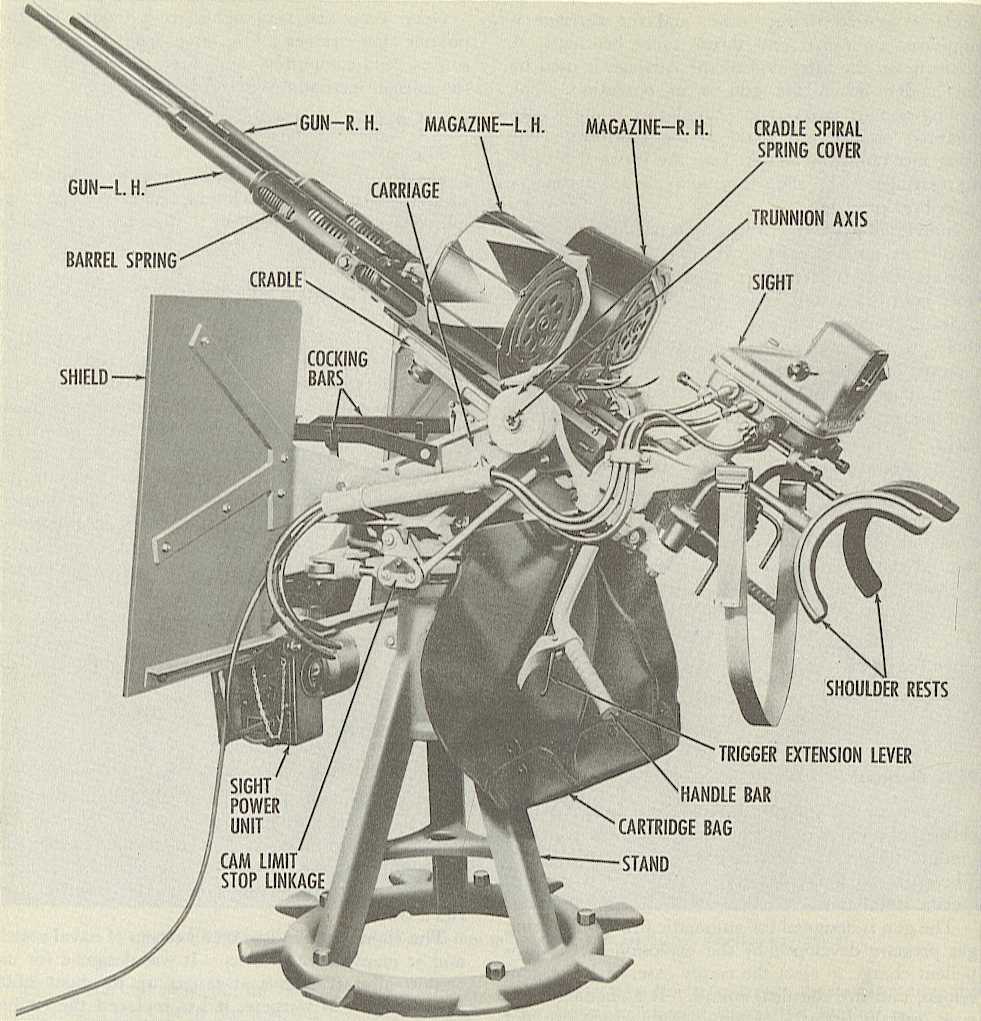
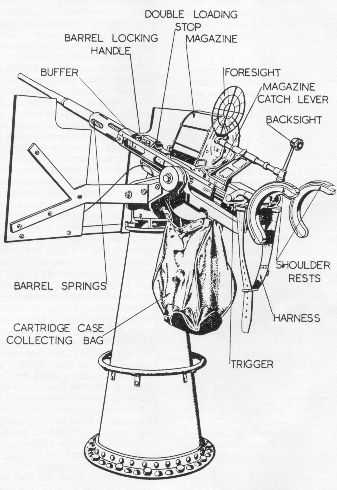
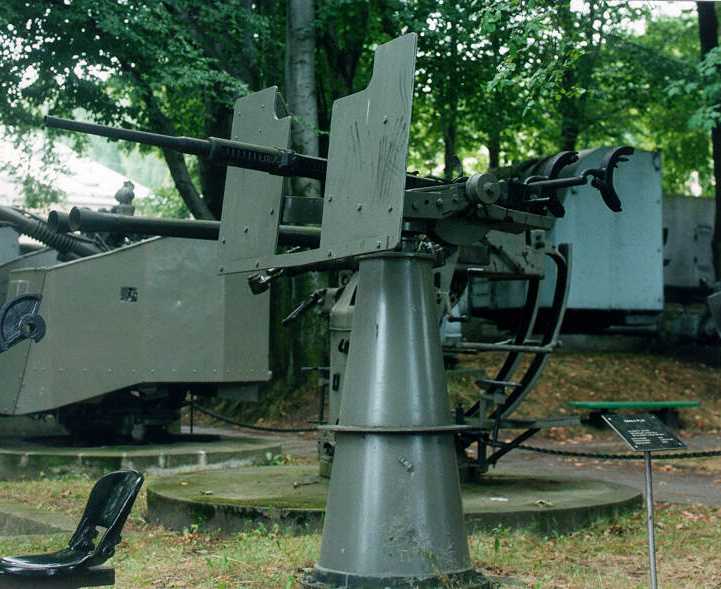
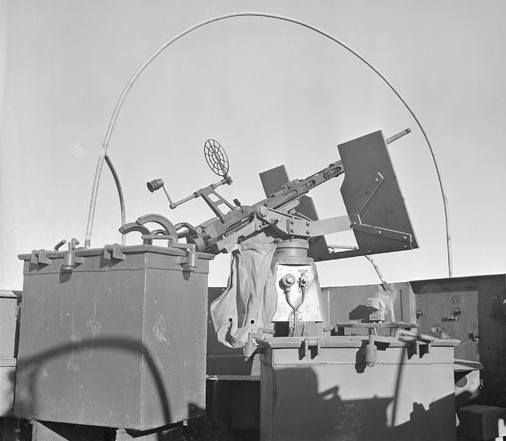
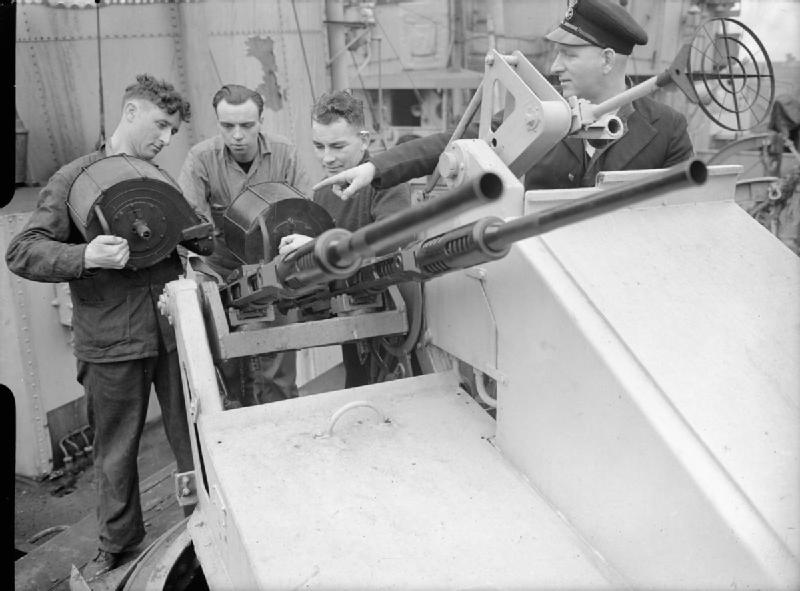
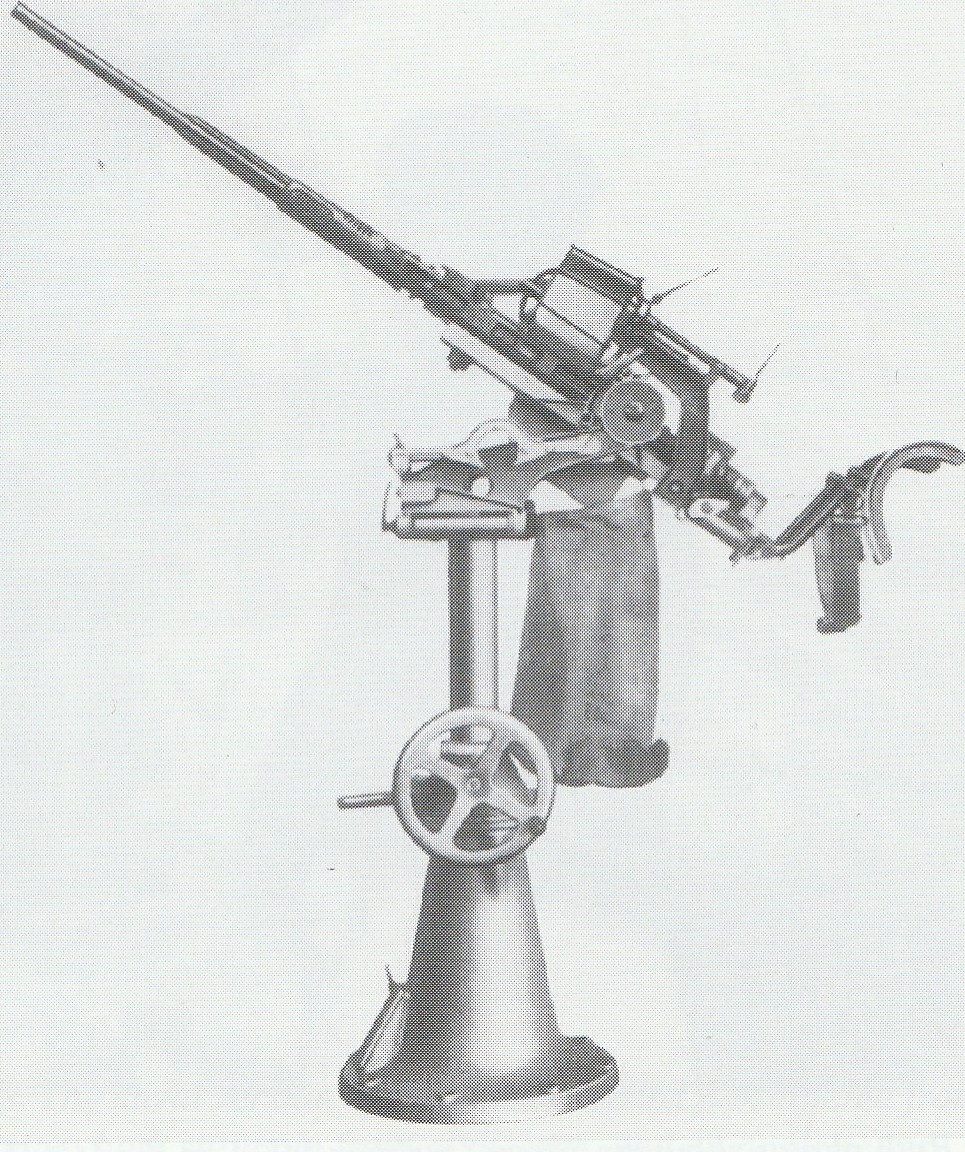
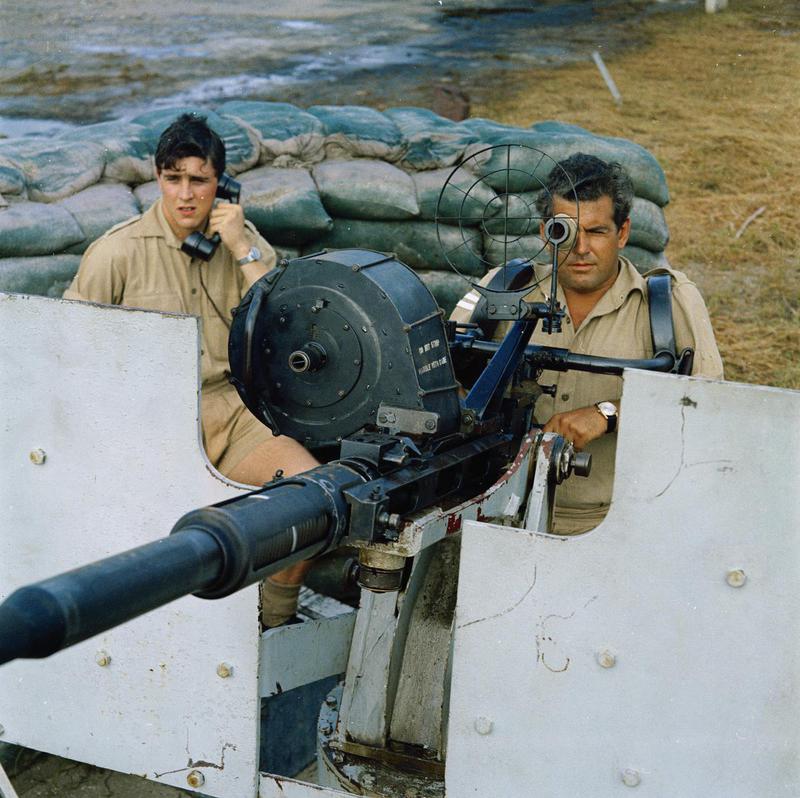
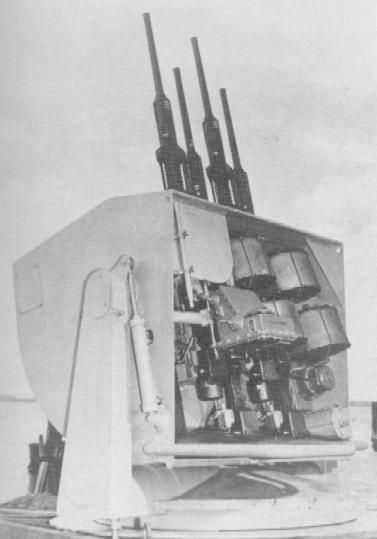
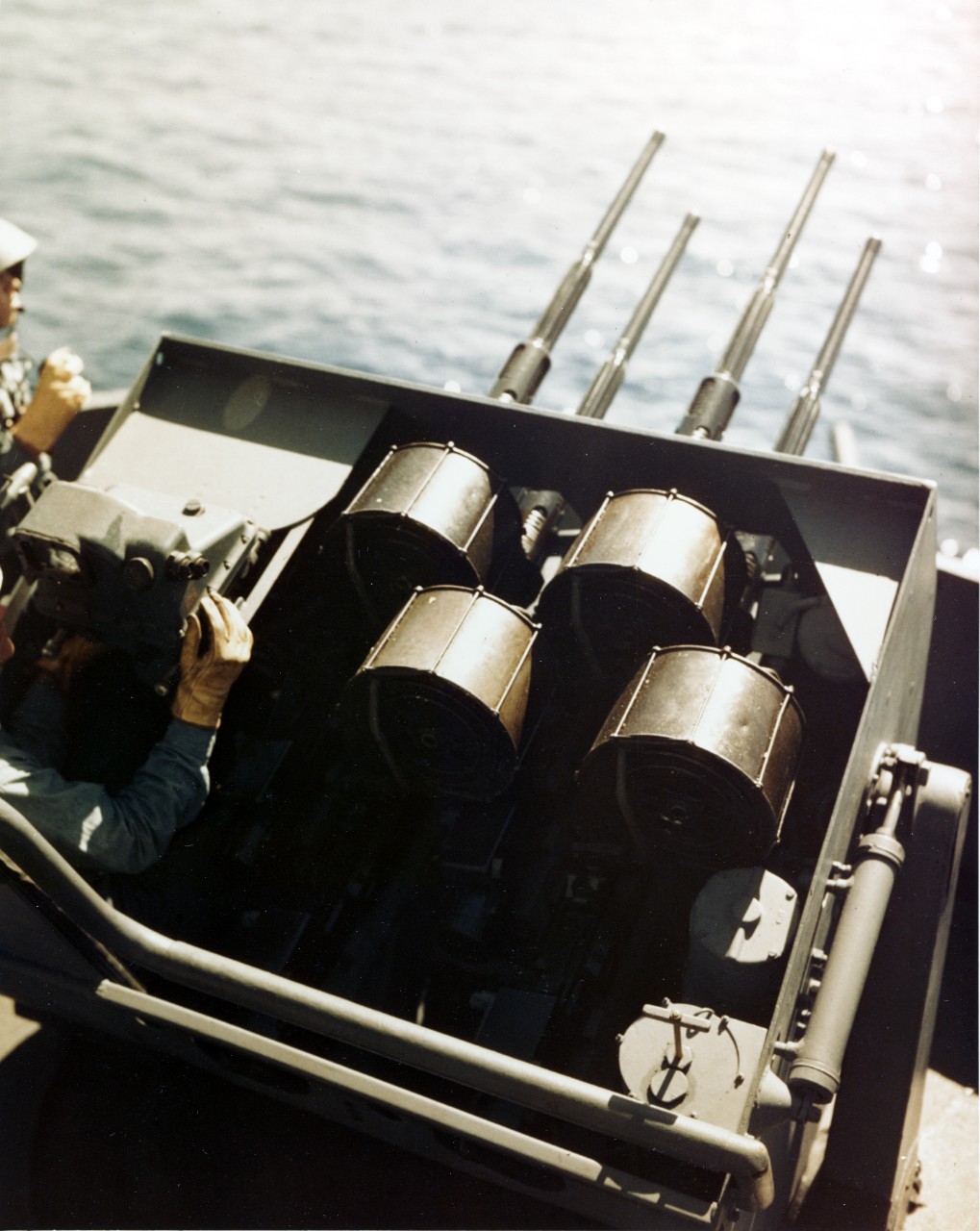

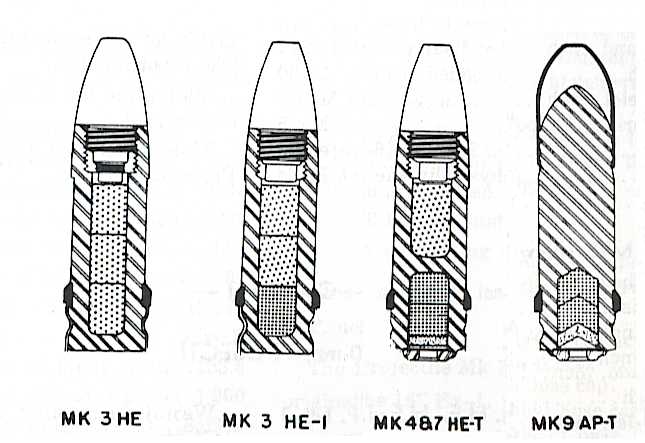
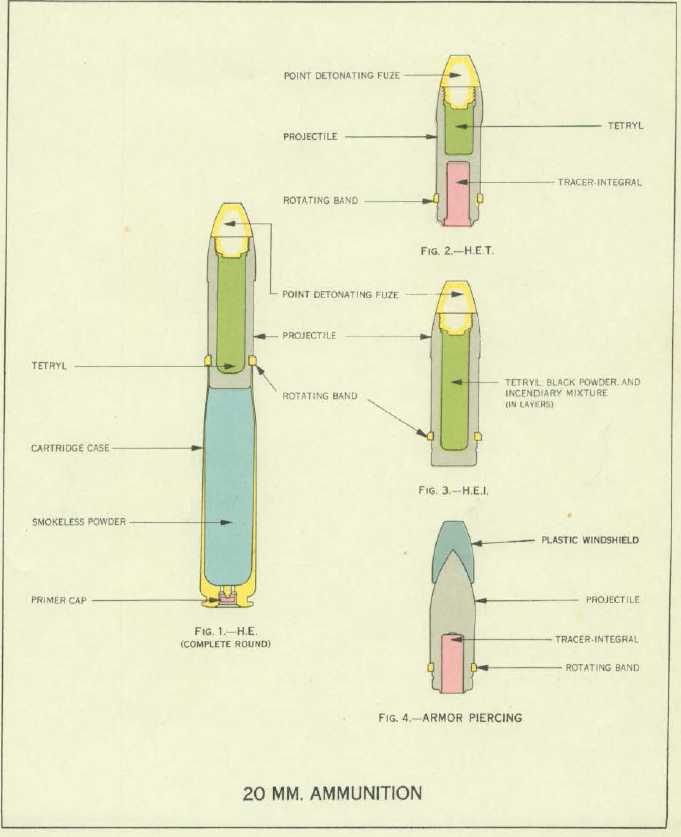
"Naval Weapons of World War Two" by John Campbell
"US Naval Weapons" by Norman Friedman
"Small Arms, Artillery & Special Weapons of the Third Reich" by Terry Gander
"Jane's Ammunition Handbook: Ninth Edition 2000-2001" edited by Terry J. Gander and Charles Q. Cutshaw
"Battleships: United States Battleships, 1935-1992" by W.H. Garzke, Jr. and R.O. Dulin, Jr.
"German 20mm FLAK in World War II" by Werner Müller
"The Secret War 1939-1945" by Gerald Pawle
"British Battleships of World War Two" by Alan Raven and John Roberts
"U.S. Navy Bureau of Ordnance in World War II" by Lt. Cmdr. Buford Rowland, USNR, and Lt. William B. Boyd, USNR
"The Yorktown Class" article by Robert F. Sumrall in "Warship 1990"
"Rapid Fire" by Anthony G. Williams
---
"Naval Ordnance and Gunnery - Navpers 16116-B - 1952" by Department of Ordnance and Gunnery, U.S. Naval Academy
"Ammunition: Instructions for the Naval Service: Ordnance Pamphlet 4 - May 1943" by Department of the Navy
"20 mm Antiaircraft Gun: Ordnance Pamphlet No. 911, March 1943" by Bureau of Ordnance (BuOrd), Department of the Navy
"Abridged Range Tables for U.S. Naval Guns: Ordnance Pamphlet No. 1188, 13 June 1944" by Bureau of Ordnance (BuOrd), Department of the Navy
"U.S. Explosive Ordnance - Ordnance Pamphlet No. 1664 - May 1947" by Bureau of Ordnance (BuOrd), Department of the Navy
---
---
Gene Slover's Navy Pages
Maritime Park Association
---
Special Help from Cliff McMullen, Robert Hurst and Vladimir Yakubov
14 May 2008 - Benchmark
30 January 2009 - Minor nomenclature change
16 January 2010 - Added picture of HMCS Prince Henry
14 January 2011 - Added data reference, added cutaway sketch
28 January 2012 - Added information on British mountings, redid picture of British mounting at Gdynia
28 December 2013 - Added photographs of HMS Starling and RAF gun
09 May 2014 - Corrected typographical error, added note about snail drum magazines, added note regarding magazine color codinh
09 May 2015 - Redid photograph of USS Iowa
29 December 2015 - Added sketch of US ammunition colors
25 August 2018 - Converted to HTML 5 format and reorganized notes
22 April 2020 - Added photograph of German C/40 single mounting
15 January 2023 - Added photograph of "Thunderbolt" mounting aboard USS West Virginia (BB-48)
10 August 2023 - Revised range table
25 March 2024 - Corrected formatting problem
20 January 2025 - Corrected hull number of USS Washington (BB-56)

